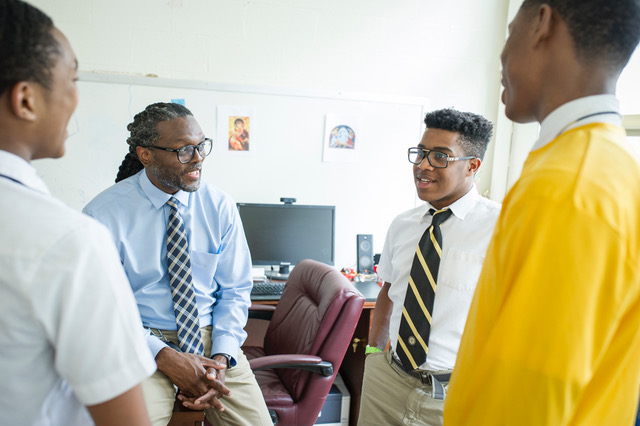In the age of COVID, Cristo Rey’s tuition-free schools face more challenges than most
For Elizabeth Goettl, CEO of the Cristo Rey Network, the COVID pandemic is raising tough questions. She’s facing the operational questions most educators are facing—How do you social distance in a classroom? What does physical education look like? Lunchtime? For 37 Catholic high schools across the country. But she’s also contending with other existential questions about funding, survival, and an educational model that puts 90 percent of its graduates in college.
In terms of operations, plenty of alternatives are available. In the Kansas City area, where Cristo Rey has a high school, some of the public school districts enable parents to choose between online or in-person learning; in others, the schools will offer in-person classes only. In Denver, another home to Cristo Rey, it’s in-person learning exclusively for public school kids. In Chicago, the public school system opted for a hybrid approach, while also allowing parental choice. Cristo Rey has three schools in Chicago. “We have to respond to local environments,” Goettl says, “and the CDC has made recommendations.”
But there’s no question where her hopes lie. “I’d like to prioritize in-person learning in a socially distant manner,” she says. “The American Academy of Pediatrics said recently that in-person learning is best.” Studies and surveys confirm that the last months of the 2019–20 school year, when schools depended on remote learning, were often ad hoc affairs, as teachers tried to master the craft of online teaching and students tried to pay attention. “The results are in for remote learning,” The Wall Street Journal announced. “It didn’t work.”
“There’s more to education than procurement,” Goettl explains. “It’s rooted in relationships.” And those relationships—with teachers and peers—are thinned in an online environment. Yet, the challenges of offering in-person learning in a pandemic are enormous. “Just the cleaning alone,” Goettl says. “And the entry and exit procedures. The handwashing.”
But it’s Cristo Rey’s model that is of most concern to Goettl. Cristo Rey is tuition-free because of its model, which puts students in jobs one day a week. Those paid work hours pay for tuition, through the generosity of employers like General Mills, Radisson Hotels, and The Art Institute of Chicago. Those paid hours also introduce underserved students to a larger world. Some may never have seen a high-rise elevator or their city’s downtown, let alone an art museum. They learn about expectations, basic procedures, opportunities. “Especially with the national conversation about race, this part of what we do is particularly important. We remove institutional barriers,” Goettl says. But in the age of COVID, some of Cristo Rey’s partner employers have stepped back. Some businesses are literally closed. Others are tentatively rotating their full-time employees.
The solution? “Cut costs,” she says, “which sounds easier than it is. Eighty percent of our budget is personnel.” That doesn’t leave much room for trimming.
Another solution: raise money. “Also a challenge,” she says.
Still, even though COVID is a force to be reckoned with, Cristo Rey is a force, too. Eighteen thousand alumni. More than $68 million earned during the school year. In one Chicago school, half the students take advanced placement exams. In New York City, 81 percent graduate college. In Baltimore, the beleaguered class of 2020, the COVID class, won $2 million in college scholarships.

